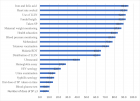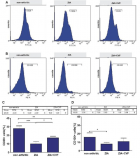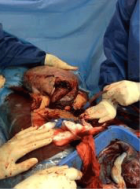Abstract
Review Article
A mouse model of coronary microvacsular disease using a photochemical approach
Xinlu Wang, Fang Liu and Zhen W. Zhuang*
Published: 18 September, 2019 | Volume 4 - Issue 3 | Pages: 120-130
The development of reproducible rodent models of coronary microvascular disease (MVD) is essential for the early detection, treatment, and mechanism study of the pathophysiology. We hypothesized that endothelial dysfunction and subsequent microthrombi in the coronary arterioles, two early events in clinical coronary MVD, could be reproduced by photochemical reaction (PCR) technology in mice hearts. After rose bengal (one of photosensitizers) was administrated systemically, a green light was locally used to activate the photosensitizer, inducing over-production of oxidative stress in the heart. Following PCR, animals demonstrated reproducible endothelial injury, occlusion in arterioles, focal ischemia, and infarct-let with preserved cardiac function. Our technique has proven to be a reliable and reproducible means of creating coronary MVD in mice. We believe that this is an ideal model for developing a novel molecular tracer for earlier detection of coronary MVD, for testing new anti-fibrinolytic drugs, and for investigating the complex pathophysiology of coronary MVD. The protocol for establishing this model takes about thirty to forty minutes.
Read Full Article HTML DOI: 10.29328/journal.jccm.1001052 Cite this Article Read Full Article PDF
References
- Shaw LJ, Merz CN, Pepine CJ, Reis SE, Bittner V, et al. Women's Ischemia Syndrome Evaluation (WISE) Investigators. The economic burden of angina in women with suspected ischemic heart disease: results from the National Institutes of Health--National Heart, Lung, and Blood Institute--sponsored Women's Ischemia Syndrome Evaluation. Circulation. 2006; 114: 894-904. PubMed: https://www.ncbi.nlm.nih.gov/pubmed/16923752
- Reis SE, Holubkov R, Conrad Smith AJ, Kelsey SF, Sharaf BL, et al. WISE Investigators. Coronary microvascular dysfunction is highly prevalent in women with chest pain in the absence of coronary artery disease: results from the NHLBI WISE study. Am Heart J. 2001; 141: 735-741. PubMed: https://www.ncbi.nlm.nih.gov/pubmed/11320360
- Pepine CJ, Anderson RD, Sharaf BL, Reis SE, Smith KM, et al. Coronary microvascular reactivity to adenosine predicts adverse outcome in women evaluated for suspected ischemia results from the National Heart, Lung and Blood Institute WISE (Women's Ischemia Syndrome Evaluation) study. J Am Coll Cardiol. 2010; 55: 2825-2832. PubMed: https://www.ncbi.nlm.nih.gov/pubmed/20579539
- Likoff W, Segal BL, Kasparian H. Paradox of normal selective coronary arteriograms in patients considered to have unmistakable coronary heart disease. N Engl J Med. 1967; 276: 1063-1066. PubMed: https://www.ncbi.nlm.nih.gov/pubmed/6025663
- Mosseri M, Yarom R, Gotsman M, Hasin Y. Histologic evidence for small-vessel coronary artery disease in patients with angina pectoris and patent large coronary arteries. Circulation. 1986; 74: 964-972. PubMed: https://www.ncbi.nlm.nih.gov/pubmed/3769180
- Suzuki H, Takeyama Y, Koba S, Suwa Y, Katagiri T. Small vessel pathology and coronary hemodynamics in patients with microvascular angina. Int J Cardiol. 1994; 43: 139-150. PubMed: https://www.ncbi.nlm.nih.gov/pubmed/8181868
- Zhuang ZW, Huang Y, Ju R, Maxfield MW, Ren Y, et al. Molecular imaging of factor XIII activity for the early detection of mouse coronary microvascular disease. Theranostics. 2019; 9: 1474-1489. PubMed: https://www.ncbi.nlm.nih.gov/pubmed/30867844
- Granger D, Rodrigues S, Yildirim A, Senchenkova E. Microvascular responses to cardiovascular risk factors. Microcirculation. 2010; 17: 192-205. PubMed: https://www.ncbi.nlm.nih.gov/pubmed/20374483
- Shaw LJ, Bairey Merz CN, Pepine CJ, Reis SE, Bittner V, et al. Insights from the NHLBI- Sponsored Women's Ischemia Syndrome Evaluation (WISE) Study: Part I: gender differences in traditional and novel risk factors, symptom evaluation, and gender-optimized diagnostic strategies. J Am Coll Cardiol. 2006; 47(3 Suppl): S4-S20. PubMed: https://www.ncbi.nlm.nih.gov/pubmed/16458170
- Pepine CJ, Kerensky RA, Lambert CR, Smith KM, von Mering GO, et al. Some thoughts on the vasculopathy of women with ischemic heart disease. J Am Coll Cardiol. 2006; 47(3 Suppl): S30-35. PubMed: https://www.ncbi.nlm.nih.gov/pubmed/16458168
- Kaski JC, Aldama G, Cosín-Sales J. Cardiac syndrome X. Diagnosis, pathogenesis and management. Am J Cardiovasc Drugs. 2004; 4: 179-194. PubMed: https://www.ncbi.nlm.nih.gov/pubmed/15134470
- Versari D, Daghini E, Virdis A, Ghiadoni L, Taddei S. Endothelial Dysfunction as a Target for Prevention of Cardiovascular Disease. Diabetes Care. 2009; 32: S314-S321. PubMed: https://www.ncbi.nlm.nih.gov/pubmed/19875572
- Cai H, Harrison DG. Endothelial dysfunction in cardiovascular disease: the role of oxidant stress. Circ Res. 2000; 87: 840-844. PubMed: https://www.ncbi.nlm.nih.gov/pubmed/11073878
- Egashira K, Hirooka Y, Kuga T, Mohri M, Takeshita A. Effects of L-arginine supplementation on endothelium-dependent coronary vasodilatation in patients with angina pectoris and normal coronary arteriograms. Circulation. 1996; 94: 130-134. PubMed: https://www.ncbi.nlm.nih.gov/pubmed/8674170
- Tousoulis D, Briasoulis A, Papageorgiou N, Tsioufis C, Tsiamis E, et al. Oxidative Stress and Endothelial Function: Therapeutic Interventions. Recent Pat Cardiovasc Drug Discov. 2011; 6: 103-114. PubMed: https://www.ncbi.nlm.nih.gov/pubmed/21513492
- Pennathur S, Heinecke JW. Oxidative stress and endothelial dysfunction in vascular disease. Curr Diab Rep. 2007; 7: 257-264. PubMed: https://www.ncbi.nlm.nih.gov/pubmed/17686400
- Griendling KK, Sorescu D, Ushio-Fukai M. NAD(P)H oxidase: role in cardiovascular biology and disease. Circ Res. 2000; 86: 494-501. PubMed: https://www.ncbi.nlm.nih.gov/pubmed/10720409
- Madamanchi NR, Runge MS. Mitochondrial dysfunction in atherosclerosis. Circ Res. 2007; 100: 460-473. PubMed: https://www.ncbi.nlm.nih.gov/pubmed/17332437
- Caccese D, Pratico D, Ghiselli A, Natoli S, Pignatelli P, et al. Superoxide anion and hydroxyl radical release by collagen-induced platelet aggregation: role of arachidonic acid metabolism. Thromb Haemost. 2000; 83: 485-490. PubMed: https://www.ncbi.nlm.nih.gov/pubmed/10744158
- Maki J, Hirano M, Hoka S, Kanaide H, Hirano K. Involvement of reactive oxygen species in thrombin-induced pulmonary vasoconstriction. Am J Respir Crit Care Med. 2010; 182: 1435-1444. PubMed: https://www.ncbi.nlm.nih.gov/pubmed/20639439
- Zhuang ZW, Shi J, Rhodes JM, Tsapakos MJ, Simons M. Challenging the surgical rodent hindlimb ischemia model with the miniinterventional technique. J Vasc Interv Radiol. 2011; 22: 1437-1446. PubMed: https://www.ncbi.nlm.nih.gov/pubmed/21459613
- Nichols TC, Bellinger DA, Reddick RL, Read MS, Koch GG, et al. Role of von Willebrand factor in arterial thrombosis: studies in normal and von Willebrand disease pigs. Circulation. 1991; 83: IV56-IV64. PubMed: https://www.ncbi.nlm.nih.gov/pubmed/2040072
- Malyar NM, Lerman LO, Gössl M, Beighley PE, Ritman EL. Relationship between Surface Area of Nonperfused Myocardium and Extravascular Extraction of Contrast Agent following Coronary Microembolization. Am J Physiol Regul Integr Comp Physiol. 2011; 301: R430-R437. PubMed: https://www.ncbi.nlm.nih.gov/pubmed/21543631
- Li L, Li DH, Qu N, Wen WM, Huang WQ. The role of ERK1/2 signaling pathway in coronary microembolization-induced rat myocardial inflammation and injury. Cardiology. 2010; 117: 207-215. PubMed: https://www.ncbi.nlm.nih.gov/pubmed/21150201
- Carlsson M, Wilson M, Martin AJ, Saeed M. Myocardial microinfarction after coronary microembolization in swine: MR imaging characterization. Radiology. 2009; 250: 703-713. PubMed: https://www.ncbi.nlm.nih.gov/pubmed/19164123
- Falk E. Unstable angina with fatal outcome: dynamic coronary thrombosis leading to infarction and/or sudden death: autopsy evidence of recurrent mural thrombosis with peripheral embolization culminating in total vascular occlusion. Circulation. 1985; 71: 699-708. PubMed: https://www.ncbi.nlm.nih.gov/pubmed/3971539
- Li SM, Zeng K, Wang WW, Zhang FL, Sun XD, et al. Time course of myocardial NF-kappaB activation post coronary microembolization. Zhonghua Xin Xue Guan Bing Za Zhi. 2008; 36: 1016-1020. PubMed: https://www.ncbi.nlm.nih.gov/pubmed/19102917
- Haft JI, Kranz PD, Albert FJ, Fani K. Intravascular platelet aggregation in the heart induced by norepinephrine. Circulation. 1972; 46: 698-708. PubMed: https://www.ncbi.nlm.nih.gov/pubmed/5072771
- Ciulla MM, Paliotti R, Ferrero S, Braidotti P, Esposito A, et al. Left ventricular remodeling after experimental myocardial cryoinjury in rats. J Surg Res. 2004; 116: 91-97. PubMed: https://www.ncbi.nlm.nih.gov/pubmed/14732353
- van Amerongen MJ, Harmsen MC, Petersen AH, Popa ER, van Luyn MJ. Cryoinjury: a model of myocardial regeneration. Cardiovascular Pathology. 2008; 17: 23-31. PubMed: https://www.ncbi.nlm.nih.gov/pubmed/18160057
- Dolmans D, Fukumura D, Jain RK. Photodynamic therapy for cancer. Nat Rev Cancer. 2003; 3: 380-387. PubMed: https://www.ncbi.nlm.nih.gov/pubmed/12724736
- Detombe SA, Dunmore-Buyze J, Drangova M. Evaluation of eXIA 160 cardiac-related enhancement in C57BL/6 and BALB/c mice using micro-CT. Contrast Media Mol Imaging. 2012; 7: 240-246. PubMed: https://www.ncbi.nlm.nih.gov/pubmed/22434637
- Morin RL, Gerber TC, McCollough CH. Radiation dose in computed tomography of the heart. Circulation. 2013; 107: 917-922. PubMed: https://www.ncbi.nlm.nih.gov/pubmed/12591765
- Hofmann JJ, Briot A, Enciso J, Zovein AC, Ren S, et al. Endothelial deletion of murine Jag1 leads to valve calcification and congenital heart defects associated with Alagille syndrome. Development. 2012; 139: 4449-4460. PubMed: https://www.ncbi.nlm.nih.gov/pubmed/23095891
- Landskroner-Eiger S, Qiu C, Perrotta P, Siragusa M, Lee MY, et al. Endothelial miR-17∼92 cluster negatively regulates arteriogenesis via miRNA-19 repression of WNT signaling. Proc Natl Acad Sci USA. 2015; 112: 12812-12817. PubMed: https://www.ncbi.nlm.nih.gov/pubmed/26417068Kivelä R, Bry M, Robciuc MR, Räsänen M, Taavitsainen M, et al. VEGF-B-induced vascular growth leads to metabolic reprogramming and ischemia resistance in the heart. EMBO Mol Med. 2014; 6: 307-321. PubMed: https://www.ncbi.nlm.nih.gov/pubmed/24448490
Figures:
Similar Articles
-
Left Atrial Remodeling is Associated with Left Ventricular Remodeling in Patients with Reperfused Acute Myocardial InfarctionChristodoulos E. Papadopoulos*,Dimitrios G. Zioutas,Panagiotis Charalambidis,Aristi Boulbou,Konstantinos Triantafyllou,Konstantinos Baltoumas,Haralambos I. Karvounis,Vassilios Vassilikos. Left Atrial Remodeling is Associated with Left Ventricular Remodeling in Patients with Reperfused Acute Myocardial Infarction. . 2016 doi: 10.29328/journal.jccm.1001001; 1: 001-008
-
Mid-Ventricular Ballooning in Atherosclerotic and Non-Atherosclerotic Abnormalities of the Left Anterior Descending Coronary ArteryStefan Peters*. Mid-Ventricular Ballooning in Atherosclerotic and Non-Atherosclerotic Abnormalities of the Left Anterior Descending Coronary Artery. . 2016 doi: 10.29328/journal.jccm.1001002; 1:
-
Concentration Polarization of Ox-LDL and Its Effect on Cell Proliferation and Apoptosis in Human Endothelial CellsShijie Liu*,Jawahar L Mehta,Yubo Fan,Xiaoyan Deng,Zufeng Ding*. Concentration Polarization of Ox-LDL and Its Effect on Cell Proliferation and Apoptosis in Human Endothelial Cells. . 2016 doi: 10.29328/journal.jccm.1001003; 1:
-
Intermittent Left Bundle Branch Block: What is the Mechanism?Hussam Ali*,Riccardo Cappato. Intermittent Left Bundle Branch Block: What is the Mechanism?. . 2017 doi: 10.29328/journal.jccm.1001004; 2:
-
Congenital Quadricuspid Aortic Valve, a Rare Cause of Aortic Insufficiency in Adults: Case ReportCyrus Kocherla*,Kalgi Modi. Congenital Quadricuspid Aortic Valve, a Rare Cause of Aortic Insufficiency in Adults: Case Report. . 2017 doi: 10.29328/journal.jccm.1001005; 2: 003-007
-
Short and Medium-Term Evaluation of Patients in Coronary Post-Angioplasty: Préliminary results at the Cardiology Department of the Hospital University Aristide Le Dantec of Dakar (Senegal): Study on 38 CasesDioum M*,Aw F,Masmoudi K,Gaye ND,Sarr SA,Ndao SCT, Mingou J,Ngaidé AA,Diack B,Bodian M,Ndiaye MB,Diao M,Ba SA. Short and Medium-Term Evaluation of Patients in Coronary Post-Angioplasty: Préliminary results at the Cardiology Department of the Hospital University Aristide Le Dantec of Dakar (Senegal): Study on 38 Cases. . 2017 doi: 10.29328/journal.jccm.1001006; 2: 008-012
-
Indications and Results of Coronarography in Senegalese Diabetic Patients: About 45 CasesNdao SCT*,Gaye ND,Dioum M,Ngaide AA,Mingou JS,Ndiaye MB, Diao M,Ba SA. Indications and Results of Coronarography in Senegalese Diabetic Patients: About 45 Cases. . 2017 doi: 10.29328/journal.jccm.1001007; 2: 013-019
-
Procedure utilization, latency and mortality: Weekend versus Weekday admission for Myocardial InfarctionNader Makki,David M Kline,Arun Kanmanthareddy,Hansie Mathelier,Satya Shreenivas,Scott M Lilly*. Procedure utilization, latency and mortality: Weekend versus Weekday admission for Myocardial Infarction. . 2017 doi: 10.29328/journal.jccm.1001008; 2: 020-025
-
Spontaneous rupture of a giant Coronary Artery Aneurysm after acute Myocardial InfarctionOğuzhan Çelik,Mucahit Yetim,Tolga Doğan,Lütfü Bekar,Macit Kalçık*,Yusuf Karavelioğlu. Spontaneous rupture of a giant Coronary Artery Aneurysm after acute Myocardial Infarction. . 2017 doi: 10.29328/journal.jccm.1001009; 2: 026-028
-
Thrombolysis, the only Optimally Rapid Reperfusion TreatmentVictor Gurewich*. Thrombolysis, the only Optimally Rapid Reperfusion Treatment. . 2017 doi: 10.29328/journal.jccm.1001010; 2: 029-034
Recently Viewed
-
Trends in TeledentistryRudrakshi C*. Trends in Teledentistry. J Clin Adv Dent. 2020: doi: 10.29328/journal.jcad.1001014; 4: 004-005
-
Au26-35: A Special Geometrical Structure of Au33 (D2) Cluster with Highly Occupied - 14 Pairs of Double-State DegeneracyK Vishwanathan*. Au26-35: A Special Geometrical Structure of Au33 (D2) Cluster with Highly Occupied - 14 Pairs of Double-State Degeneracy. Ann Adv Chem. 2022: doi: 10.29328/journal.aac.1001035; 6: 063-080
-
Texture of Thin Films of Aluminum Nitride Produced by Magnetron SputteringStrunin Vladimir Ivanovich,Baranova Larisa Vasilievna*,Baisova Bibigul Tulegenovna. Texture of Thin Films of Aluminum Nitride Produced by Magnetron Sputtering. Int J Phys Res Appl. 2025: doi: 10.29328/journal.ijpra.1001106; 8: 013-016
-
Minimising Carbon Footprint in Anaesthesia PracticeNisha Gandhi and Abinav Sarvesh SPS*. Minimising Carbon Footprint in Anaesthesia Practice. Int J Clin Anesth Res. 2024: doi: 10.29328/journal.ijcar.1001025; 8: 005-007
-
On Friedman equation, quadratic laws and the geometry of our universeS Kalimuthu*. On Friedman equation, quadratic laws and the geometry of our universe. Int J Phys Res Appl. 2021: doi: 10.29328/journal.ijpra.1001041; 4: 048-050
Most Viewed
-
Evaluation of Biostimulants Based on Recovered Protein Hydrolysates from Animal By-products as Plant Growth EnhancersH Pérez-Aguilar*, M Lacruz-Asaro, F Arán-Ais. Evaluation of Biostimulants Based on Recovered Protein Hydrolysates from Animal By-products as Plant Growth Enhancers. J Plant Sci Phytopathol. 2023 doi: 10.29328/journal.jpsp.1001104; 7: 042-047
-
Sinonasal Myxoma Extending into the Orbit in a 4-Year Old: A Case PresentationJulian A Purrinos*, Ramzi Younis. Sinonasal Myxoma Extending into the Orbit in a 4-Year Old: A Case Presentation. Arch Case Rep. 2024 doi: 10.29328/journal.acr.1001099; 8: 075-077
-
Feasibility study of magnetic sensing for detecting single-neuron action potentialsDenis Tonini,Kai Wu,Renata Saha,Jian-Ping Wang*. Feasibility study of magnetic sensing for detecting single-neuron action potentials. Ann Biomed Sci Eng. 2022 doi: 10.29328/journal.abse.1001018; 6: 019-029
-
Pediatric Dysgerminoma: Unveiling a Rare Ovarian TumorFaten Limaiem*, Khalil Saffar, Ahmed Halouani. Pediatric Dysgerminoma: Unveiling a Rare Ovarian Tumor. Arch Case Rep. 2024 doi: 10.29328/journal.acr.1001087; 8: 010-013
-
Physical activity can change the physiological and psychological circumstances during COVID-19 pandemic: A narrative reviewKhashayar Maroufi*. Physical activity can change the physiological and psychological circumstances during COVID-19 pandemic: A narrative review. J Sports Med Ther. 2021 doi: 10.29328/journal.jsmt.1001051; 6: 001-007

HSPI: We're glad you're here. Please click "create a new Query" if you are a new visitor to our website and need further information from us.
If you are already a member of our network and need to keep track of any developments regarding a question you have already submitted, click "take me to my Query."

















































































































































